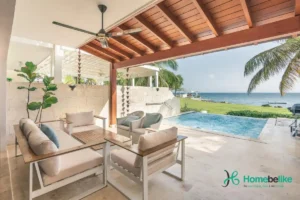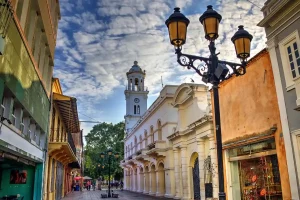Where is La Romana? It is located on the southeastern coast of the Dominican Republic. It is approximately 1.5 hours from Santo Domingo and just under an hour from Punta Cana. As a result, its ideal location makes it a natural hub for visitors seeking easy access to both vibrant cities and secluded beaches. La Romana evolved from a port town into a dynamic destination. Therefore, it offers some of the country’s most exclusive experiences.
Why is La Romana Important? Discover where is La Romana
More than just a dot on the map, La Romana is a cornerstone of the Dominican Republic’s identity and economy. Indeed, if you’ve ever wondered about La Romana, you’ll find that it’s not only a geographic location. Moreover, it is also a thriving hub that blends history, culture, and modern tourism.
Strategic coastal location: where is La Romana on the map?
If you’ve ever asked yourself about La Romana, here’s why its location matters. La Romana’s strategic location on the Caribbean coast gives it a unique advantage within the Dominican Republic. Its thriving port welcomes cruise ships, private yachts, and fishing boats.
The city is also conveniently close to international airports, including La Romana International Airport (LRM). It connects directly to major cities in the United States and Europe, and Punta Cana International Airport. As a result, these factors explain why so many visitors ask themselves where is La Romana when planning a Caribbean escape.
Gateway to luxury and heritage
Just minutes from the city lies Casa de Campo Resort & Villas. Within its gated community, guests can enjoy:
- Three world-renowned golf courses include the famous Teeth of the Dog, designed by legendary Pete Dye. It is often ranked among the best in the world for its dramatic seaside holes.
- Gourmet restaurants that celebrate local Dominican flavors and international cuisine, offering everything from fine dining experiences to relaxed beachside meals.
- Private beaches with soft white sand and crystal-clear waters. They are perfect for romantic walks, sunbathing in privacy, or enjoying a cocktail with the sound of waves.
- Polo fields and an equestrian center where guests can watch exciting matches or even take riding lessons for a unique and elegant pastime.
A short distance away, you’ll find the spectacular Altos de Chavón. An open-air museum and cultural village meticulously crafted as a replica of a 16th-century Mediterranean town. Here, visitors can wander cobblestone streets and discover:
- Artisan shops showcasing handcrafted jewelry, textiles, and ceramics made by local artists.
- Art galleries exhibiting both Dominican and international works, making it a hub for creativity and inspiration.
- A Roman-style amphitheater, an architectural masterpiece that has hosted performances by world-class artists such as Frank Sinatra, Sting, and Andrea Bocelli.
- Panoramic views showcase the countryside, where lush green hills meet the deep blue of the river. This creates an unforgettable backdrop for photos and quiet reflection.
In conclusion, these world-class attractions establish La Romana as a premier luxury destination. Therefore, it offers a perfect blend of high-end leisure and rich cultural heritage for any discerning traveler.
Things to do in and around: find out where is La Romana
Knowing where is La Romana helps you plan your itinerary more efficiently. One of the highlights is beach hopping and island escapes. Bayahibe Beach, with its calm turquoise waters, is perfect for a laid-back day in the sun.
For those who love marine life, Catalina Island is an underwater paradise. It is ideal for snorkeling and scuba diving. And just a short boat ride away lies Saona Island, a tropical haven.
But La Romana isn’t just about beaches. You should truly understand where is La Romana’s cultural soul. You can tour local sugarcane plantations and learn about the region’s economic roots.
For nature lovers, La Romana also delivers. You can kayak along the Chavón River, hike eco-trails near Bayahibe, or explore Cotubanamá National Park.
Local gastronomy in La Romana: where is La Romana and its flavor?
If you want to taste the culture truly, look beyond resort dining. The real essence of where is La Romana is found in its authentic Dominican cuisine. From small family-run eateries to roadside fondas and beachfront shacks, the local gastronomy reflects a fusion of tradition and creativity.
Some must-try dishes include:
- Chenchén con chivo. A savory cracked corn and goat stew typical of the southeastern region.
- Pescado con coco. Fresh fish cooked in a creamy coconut sauce, often served with tostones and rice.
- Habichuelas con dulce. A sweet dessert made of beans, milk, and spices, especially popular during Holy Week.
Beyond the flavors, eating in La Romana is also about the experience. You might discover family-run spots that pass recipes down through generations. As a result, they offer visitors a direct connection to Dominican heritage.
Where is La Romana: Traditions
La Romana is part of a vibrant Afro-Caribbean cultural belt that includes Batey communities. These communities are rich in oral history, spirituality, and traditional music.
Palo, gaga, and tambú rhythms
If you visit during a festival or holiday, you might witness traditional Afro-Dominican music like palo. This drumming-based ritual is often linked to spiritual ceremonies. In Bateyes (located nearLa Romana), music is more than entertainment, it’s a connection to ancestry and community identity.
Some local NGOs and cultural centers offer ethical, small-group tours to learn about this heritage. Visitors can attend music workshops and support community artists directly.
Contemporary art and creative scene: discover where is La Romana
Most tourists flock to Altos de Chavón for its galleries and art school. But there’s a more grassroots creative movement bubbling up in La Romana city itself.
Street murals and youth collectives
Walk through neighborhoods like Villa Verde or Savica and you’ll see bold murals reflecting social themes, national pride, and Afro-Dominican identity. These pieces are often created by youth art collectives aiming to reclaim public spaces and challenge stereotypes.
Some artists work with recycled materials, creating stunning sculptures from found objects. This serves partly as a statement about sustainability and urban resilience.
The artisan economy: handmade culture
For travelers wondering where is La Romana in terms of local crafts, the city is a hub of creativity and tradition:
- Larimar jewelry. This rare blue stone is found only in the Dominican Republic. Some artisans craft it right in front of you.
- Guano baskets and hats. Made from palm fibers by elderly craftsmen in rural villages.
- Hand-carved maracas and percussion instruments. It is often used in palo and merengue performances.
You can find many of these crafts at small markets near the central plaza or during weekend pop-ups coordinated by local artist associations.
Unexpected wildlife encounters
While most guides focus on beaches and coral reefs, those asking where is La Romana in terms of biodiversity will discover unique animal life in the surrounding ecosystems:
- Hispaniolan solenodon. A rare, nocturnal mammal found in protected areas near Cotubanamá National Park.
- Roseate spoonbill. A striking pink bird is often seen in the coastal wetlands at sunrise.
- Cave bats. In dry caves near the Chavón River, some species of insectivorous bats create surreal evening spectacles.
As a result, several eco-tour operators now offer guided wildlife walks and night tours, making La Romana a rewarding destination for birdwatchers and biology buffs.
Community-based tourism in rural La Romana
A growing trend in Dominican tourism is community-based tourism. For instance, homestays with Dominican families allow visitors to share meals, stories, and traditions in an authentic setting. Another option is agricultural tours. They offer the chance to walk through cacao or plantain farms, learn about sustainable farming methods, and taste food harvested the same day.
For a deeper connection with nature, village-led river tours invite travelers onto small boats or kayaks, guided by locals who explain the ecology and history of the area. These experiences not only support local development. But also provide meaningful human connection and insight that no resort can replicate.
Religious and spiritual tourism
Dominicans are deeply spiritual, and La Romana reflects this through its churches, pilgrimages, and sacred sites. One of the most emblematic is the Santuario San Estanislao de Cracovia, known for its stained-glass windows and peaceful atmosphere. Also, another significant experience is the pilgrimage route to Higüey. Here, some visitors choose to walk or bike part of this sacred path that culminates at the Basílica de Nuestra Señora de la Altagracia.
Even if you’re not religious, these sites offer moments of reflection, beauty, and connection to Dominican values and traditions.
Voluntourism and impact travel
Visitors can participate in ethical tourism initiatives, from teaching English to coastal cleanups. As a result, knowing where is La Romana helps travelers choose programs that genuinely impact local communities.
Some of the most rewarding experiences include teaching English in local schools and joining coastal cleanup initiatives. As a result, you’ll gain a more authentic connection to the local culture. Finally, some of the memories you create will be more meaningful than any postcard.
Adventure sports you didn’t know were here
While hiking and scuba diving get most of the attention, La Romana also hosts a few surprising adventure activities. For instance, mountain biking along scenic sugarcane trails offers an exhilarating way to experience the countryside. On the other hand, cave exploration with knowledgeable local guides reveals hidden natural wonders.
Many of these experiences are run by small, community-based businesses. Therefore, this allows visitors to support the local economy. In addition to pushing your limits, these adventures often provide a deeper connection to the region’s culture and natural beauty.
Where is La Romana? The best time to visit
Nestled on the southeastern coast of the Dominican Republic, La Romana enjoys a warm tropical climate all year round. The best time to visit is between December and April. During this period, there are sunny skies and dry weather. As a result, beach days are perfect, and the Caribbean waters are calm for snorkeling, sailing, or simply floating under the sun.
How to get to La Romana
Getting to La Romana is surprisingly easy. Furthermore, La Romana International Airport (LRM) welcomes direct flights from major cities across the U.S. and Europe. Whereas you prefer a road trip, modern highways link La Romana to Punta Cana, Santo Domingo, and surrounding towns. As a result, this option gives travelers the flexibility to explore sugarcane fields, hidden beaches, and charming local villages along the way.
Where is La Romana: where to stay
La Romana offers accommodations for every type of traveler. For example, for a secluded, intimate experience, private luxury villas provide privacy and personalized service. On the other hand, those looking for convenience and relaxation can opt for all-inclusive resorts. Whether you’re seeking adventure or pure relaxation, La Romana has a stay that fits your perfect getaway.
Therefore, for a truly personalized experience, Homebelike offers a curated portfolio of exclusive homes through its reserve collection.
Where is La Romana, and why should you visit?
Although La Romana has plenty of tourism, most people visiting this place will never see its authentic soul. Beyond the pristine beaches and luxury villas is a world of music, art, food, ritual, ecology, and resistance. Consequently, they reveal the true complexity of this Caribbean jewel.
You now know where is La Romana: plan your getaway
In conclusion, whether drawn to turquoise beaches, historical charm, or luxury lifestyle, where is La Romana is no longer a mystery. Homebelike experiencies ensure effortless planning with island-hopping, cultural tours, and wellness retreats tailored to you. Visit Homebelike to start your dream Caribbean escape.
References
Encircle Photos. (2025). La Romana, Dominican Republic travel guide.
Explore La Romana. (2022). Useful information.
Pleasant Holidays. (2025). La Romana vacations & things to do.
The Times Travel. (2024, February 1). Dominican Republic travel guide. The Times.



